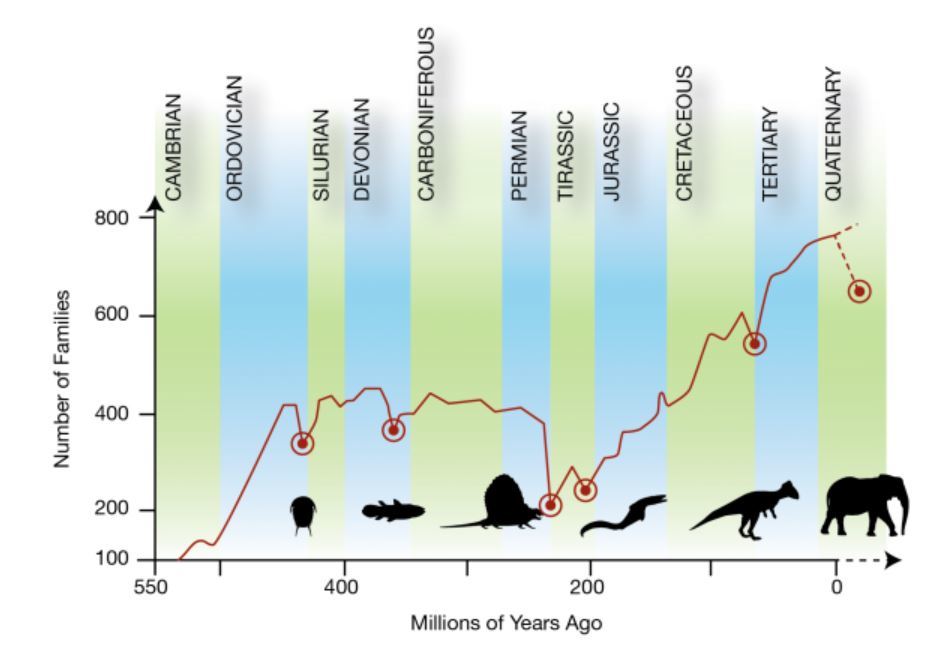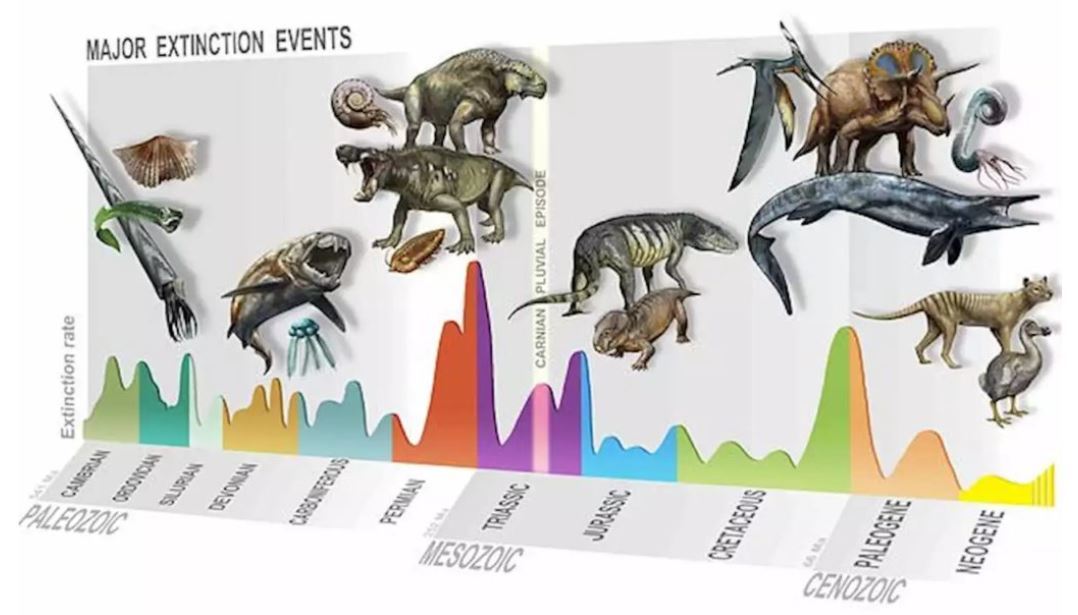 A mass extinction is usually defined as a loss of about three quarters of all species in existence across the entire Earth over a “short” geological period of time. Given the vast amount of time since life first evolved on the planet, “short” is defined as anything less than 2.8 million years.
A mass extinction is usually defined as a loss of about three quarters of all species in existence across the entire Earth over a “short” geological period of time. Given the vast amount of time since life first evolved on the planet, “short” is defined as anything less than 2.8 million years.
Significant sea-level falls are associated with most of the mass extinctions, including all of the "Big Five"—End-Ordovician, Late Devonian, End-Permian, End-Triassic, and End-Cretaceous.
- Ordovician-silurian Extinction: 440 million years ago.
- Devonian Extinction: 365 million years ago.
- Permian-Triassic Extinction: 250 million years ago.
- Triassic-Jurassic Extinction: 210 million years ago.
- Cretaceous-Tertiary Extinction: 65 Million Years Ago.
 We are definitely going through a sixth mass extinction. ' Never before has a single species been responsible for such destruction on Earth. 'The current rate of extinction is between 100 and 1,000 times higher than the pre-human background rate of extinction, which is jaw-dropping. For the last 10000 years, Earth has been in the midst of yet another extinction event that is rapidly removing animals from our planet.
We are definitely going through a sixth mass extinction. ' Never before has a single species been responsible for such destruction on Earth. 'The current rate of extinction is between 100 and 1,000 times higher than the pre-human background rate of extinction, which is jaw-dropping. For the last 10000 years, Earth has been in the midst of yet another extinction event that is rapidly removing animals from our planet.
Mass extinctions happen because of climate change, asteroid impacts, massive volcanic eruptions or a combination of these causes.
Lumachelas are rapid mass extinction events that are recorded in carbonate rocks and this earthcache will take you to see the results of one of these extinction events. By definition Lumachelas are sedimentary rocks made up entirely of shells or the carapaces of marine organisms.
In the Cretaceous limestone sequence outcropping in the Parede area, some of the strata have interbedded lumachelas.
To claim this EarthCache:
Go to the posted coordinates (note the terrain rating) and answer the following questions:
- The lumachela outcrops horizontaly in an area of X m2. What is the value of X?
- What are the main organisms that have died here? A - Bivalves, B- Crabs, C- Sea Lions, D- Limpets, E- Barnacles (Choose the correct option)
- How thick is the layer at this location? A- 0.60m, B- 1.0 m, C- 0.15 m, D- 0.01 m, E- 2.0 m (Choose the correct option)

Cartoon by: Matt Davies
Uma extinção em massa é geralmente definida como a perda de cerca de três quartos de todas as espécies existentes em toda a Terra durante um “curto” período geológico . Dado o vasto período de tempo desde que a vida evoluiu pela primeira vez no planeta, “curto” é definido como qualquer coisa inferior a 2,8 milhões de anos.
Alterações significativas do nível do mar estão associadas à maioria das extinções em massa, incluindo todos os "Cinco Grandes" - Ordovícico Superior, Devónico Superior, Pérmico Superior, Triássico Superior e Cretácico Superior.
Extinção Ordovícico-Silúrico: 440 milhões de anos atrás.
Extinção Devónico: 365 milhões de anos atrás.
Extinção Pérmico- Triássico: 250 milhões de anos atrás.
Extinção Triássico-Jurássico: 210 milhões de anos atrás.
Extinção Cretácico-Terciário: 65 milhões de anos atrás.

Estamos definitivamente a passar por uma sexta extinção em massa. “Nunca antes uma única espécie foi responsável por tamanha destruição na Terra. “A taxa atual de extinção é entre 100 e 1000 vezes maior do que a taxa de extinção pré-humana. Nos últimos 10000 anos, a Terra esteve no meio de mais um evento de extinção que está a remover rapidamente os animais do nosso planeta.
Extinções em massa acontecem devido a mudanças climáticas, impactos de asteróides, erupções vulcânicas massiças ou uma combinação de todas estas causas.
Lumachelas são eventos de extinção em massa rápida que são registrados em rochas carbonatadas e esta EarthCache vai-te levar a um local para ver os resultados de um desses eventos de extinção. Por definição, Lumachelas são rochas sedimentares constituídas inteiramente por conchas ou carapaças de organismos marinhos.
Na aflorante sequência de calcários de idade Cretácica na área da Parede, alguns dos estratos apresentam lumachelas intercaladas.
Para registar esta EarthCache:
Vai para as coordenadas (cuidado com a classificação do terreno) e responde às seguintes perguntas:
- A lumachela aflora horizontalmente em uma área de X m2. Qual é o valor de X?
- Quais são os principais organismos que morreram aqui? A - Bivalves, B- Crabs, C- Sea Lions, D- Lapas, E- Barnacles (escolhe a opção correcta)
- Qual é a espessura da camada neste local? A- 0,60m, B- 1,0 m, C- 0,15 m, D- 0,01 m, E- 2,0 m (escolhe a opção correcta)


 The most exciting way to learn about the Earth and its processes is to get into the outdoors and experience it first-hand. Visiting an Earthcache is a great outdoor activity the whole family can enjoy.
The most exciting way to learn about the Earth and its processes is to get into the outdoors and experience it first-hand. Visiting an Earthcache is a great outdoor activity the whole family can enjoy.
An Earthcache is a special place that people can visit to learn about a unique geoscience feature or aspect of our Earth. Earthcaches include a set of educational notes and the details about where to find the location (latitude and longitude). Visitors to Earthcaches can see how our planet has been shaped by geological processes, how we manage the resources and how scientists gather evidence to learn about the Earth. To find out more click HERE.